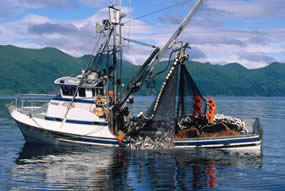Alaska Summer Fishing Jobs & Deckhand Jobs
 If you desire to work as
a deckhand in Alaska during the summer, chances are that you will be
working on a salmon fishing boat. Although, there are other fisheries
that are in operation during the summer months, salmon is king during
the summer in Alaska.
If you desire to work as
a deckhand in Alaska during the summer, chances are that you will be
working on a salmon fishing boat. Although, there are other fisheries
that are in operation during the summer months, salmon is king during
the summer in Alaska.
This is particularly true if you are a student and are working in Alaska during your summer break from school. Thousands of college students travel up to Alaska each summer to work in the salmon fisheries.
There are three type of salmon fishing boats that fish in Alaska's waters:Trolling for Salmon
Trolling is different from other types of fishing, in that the quality of the fish is stressed over sheer quantity. Typically, four stainless steel lines, each equipped with 8-12 leaders and a variety of lures, baited hooks and flashers are dragged from a slow moving boat. The lines are periodically reeled in to remove the fish and rebait the hooks. The leaders (18-36 feet of 50-80 lb. test line) must be pulled in by hand. The troller's deckhand will often experience the thrill of fighting a 60-pound king salmon, inch by inch, much like sport fishing.
Once on board the boat, the fish are gutted, then cleaned and iced in the boat hold. In good weather these tasks are quite pleasant, however the the sea can become rough, and sometimes the catch has to be hauled in and cleaned in pounding rain, strong winds and twelve foot swells.
Trolling for salmon is considered an art by most fishermen, as there a number of variables to contend with - types of lures and bait, depth, speed and area to fish, etc. Because of this, it pays to work with an experienced skipper - a skipper with a "sixth" sense. It is this sense which enables him to find fish when no one else can.
Working on a salmon troller is not physically demanding, although you will generally need to work long hours. A crew may work sixteen hour days for three weeks straight, with many skippers fishing every day unless driven in by a severe storm.
Trollers have been doing very well from an earnings stand point. Although the price for salmon is low for some of the other fisheries, Alaska's salmon trollers have seen the prices they get for the salmon remain strong, which puts much more money into the pockets of the skipper and his crew.
Gillnetters for Salmon
Working on a gillnetter is a good way to break into Alaska's salmon fishing industry. The gillnet is long, straight and has floats on the top edge and weights along the bottom. It forms a wall in the water and is designed to entangle fish in the mesh by catching them by the gills. A single "set" may last anywhere from a few minutes to the better part of the day, depending upon weather, the number of fish being caught and the area one is fishing.
Bristol Bay and Southeast Alaska are the two best areas in which to concentrate. In Southeast the gillnet season runs from early July to mid-September. The Department of Fish and Game designates a 2-3 day fishing period "opening", during which most gillnetters fish day and night for the period of the opening. The fishermen then wait a few days until the next opening. This allows the fishermen time to rest and enjoy the site seeing and recreational activities in Alaska.
Purse Seiners
Purse seining is the most productive of the salmon harvesting methods. The technique utilizes a large seine net to encircle migrating schools of salmon. The nets range from 90-250 fathoms (one fathom equals six feet) depending on the regional restrictions. Once the fish are encircled, the bottom of the net is drawn closed using a "purse line" to form a funnel-like shape. the net is then hauled aboard the boat with the aid of a hydraulic power block at the end of the seiner's boom, then the fish are dumped into the boat hold. The whole procedure is called a "set." A good set yields over 3,500 fish, and under ideal conditions, may be completed in as little as 40 minutes.
Purse seiners require a crew of 4-6 people who are compatible and able to work together efficiently as team. Because of the size of the crew, finding a jobs on a purse seiner is easier than on other boats.
Purse seine boats are up to 58 feet in length and many are very modern. Many of them have color TV's, DVD players, saunas and other amenities to make your time off more enjoyable.
If you are interested in finding out more information about working as a deckhand in Alaska, we recommend the following resources:
